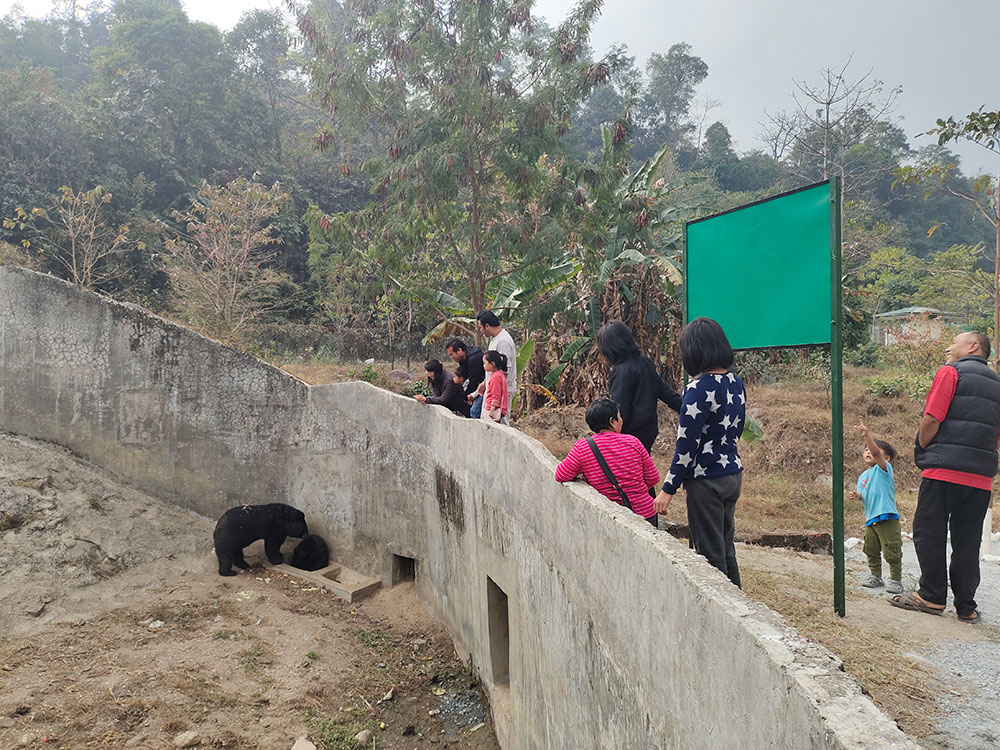Lhakpa Quendren
Seven-year-old Sherub Lhamo Phuentsho from Sarpang, an avid fan of Animal Planet and National Geographic, fulfilled her dream of seeing crocodiles, and gharials for the first time at the Southern Wildlife and Rescue Center in Sarpang. Now, this rescue centre has become her favourite spot.
“They (crocodiles and gharials) are taking a rest. Let’s keep quiet and not disturb them. They are resting outside the pond because it is cold in the water,” Sherub Lhamo said in a serious conversation with her father at the rescue centre.
Recognising his daughter’s enthusiasm for wildlife, Sherub Lhamo’s father, a businessman at Shechamthang and an Animal Planet enthusiast himself, has taken his daughter to the rescue centre. “She has gained a wealth of knowledge through television. I plan to bring her here more often whenever I visit Gelephu.”

Southern Wildlife and Rescue Center houses crocodiles, gharials, and bears
The centre is home to five crocodiles and features two ponds for gharials and two bears as their neighbours.
Like Sherub, many parents from near and far visit the centre. The centre has seen an increasing number of visitors even before it was officially opened on January 23.
“There will be more visitors and business. Some visitors bring their children from Paro and Thimphu just to witness the crocodiles,” said Karma Yangzom, a 67-year-old resident of Chhoekhorling, who visited with her two-and-a-half-year-old great-grandson.
Going by the centre’s records, at least 30 to 40 people, including Indians from neighbouring towns, have visited daily during the three days since opening to visitors.
The entry fee for local visitors is Nu 25 per person and Nu 50 for foreigners. However, some visitors believe that the current fee seems minimal, considering the cost of providing meat to rescued animals, which might burden the government.
“I believe a fee of Nu 40 to Nu 50 per visitor is reasonable. By paying the entry fee, we are contributing to the well-being of the animals, while also accumulating merits in return,” said Karma Yangzom.
Despite not being widely known at its new location, the wildlife rescue centre, located a few metres from Jigmeling along the Menchhuthang farm road, is expected to significantly contribute to the local economy due to the impressive number of visitors.
Sarpang’s forestry officer Wangdi said that increased visitor traffic to the centre, including visitors from across the border, will indirectly benefit local communities. “Local shops, restaurants, and other businesses should see increased business and income opportunities.”
“These initiatives provide several positive outcomes, including fostering cross-border relationships, raising awareness of wildlife conservation among local communities, and many others,” he said.
The World Wildlife Fund (WWF) Bhutan supported the Sarpang forestry division in developing infrastructure, such as a cafeteria and wider, improved roads, enabling the centre to open to visitors and meet longstanding public demand for access.
Ecotourism development
The WWF, under the International Climate Initiative (IKI), supported the ecotourism development for Pakhadura Recreational Area in Samtse, Nindukha to Do Namkhai Kaw hiking trail in Dagana, Shougay Latsho Eco-Trail in Gedu, and amenities at Dungkar Nye in Zhemgang, which is expected to benefit 21,740 people.
To enhance the ecotourism experience at Shougay Latsho in Gedu, roadblocks have been cleared and bushes removed, where thick bamboo had previously obstructed the path. The development includes constructing wooden bridges, canopies, resting benches along the trek, and establishing a camp house at the lake.
While currently lacking international and regional tourist visits, the lake has been consistently utilised by local visitors. The lake holds considerable potential for positively influencing local economies and communities, according to Gedu forest officials.
Given its remote location, forest officials said that the lake presents future potential for high-quality trekking experiences in the wilderness. “This initiative can bring diverse benefits from direct financial gains to environmental conservation.”
“The arrival of visitors is expected to contribute revenue to Gedu’s local economy, including accommodation, food services, transportation, and the utilisation of local guide services,” said the official.
Following the development of the eco-trail from Nyindukha Lhakhang to Do Namkhai Kaw, visitors to Nyindukha Lhakhang have begun to explore the newly developed trail and the sacred place (Do Namkhai Kaw), which was previously a leech-infested area without a proper trail.
According to residents of the Nyindukha communities, the number of visitors to Do Namkhai Kaw has increased drastically. “The development of eco-trail along Nyindukha and Do Namkhai Kaw would never remain idle or underutilised.”
“The project was proposed after repeated pleas from the communities of Nyindukha, who appease the local deity once every year. Moreover, the historic sites as such will never be devoid of its devotees,” said the forest officials.
At Pakhadura Lake under Sangachoeling in Samtse, the installation of several amenities such as parking facilities, the Namgay Khangzang chorten, safety railings, ornamental plantations, and waste bins has transformed the site into a promising ecotourism destination.
The site serves as a recreational spot for Samtse residents and Indians across the border, with the potential to attract more visitors due to its proximity to the highway. Currently, there are a few households that have set up makeshift stalls for selling local products.
To ensure economic benefits and sustainability in the future, the Samtse Forests Division plans to develop a business plan for community management. Forest officials highlighted that the development of additional facilities is necessary to unlock the site’s full potential and build community confidence.
For a long time, Pakhadura Lake has served as a crucial water source for irrigation for the locals and communities downstream. “Securing the lake is also about enhancing access to water supply which in the long run would result in securing water supply,” said the official.
In Zhemgang, enhanced facilities at Dungkar Nye in Buli under Nangkhor gewog have led to more visitors. This has helped homestays, shops, and farmers selling local farm produce earn more income.
Buli village has 14 homestays, with only a few certified by the Department of Tourism. With no commercial lodging facilities in the area, officials and visitors spend their nights at these homestays, contributing to household and shop incomes.
Tshewang Lhamo, who initiated the first homestay business in Buli, said that homestays are currently profitable. She added that her homestay occasionally receives about 15 guests a month during the peak season pilgrimage to Buli Lake and Dungkar Ney. “Many homestay owners have renovated and expanded their accommodations due to its viability as a business.”
Zhemgang forest officials said that Buli Tsho has become a popular pilgrimage site in Zhemgang, attracting visitors from across the country. Officials said that improving trails from the road point to the Nye is necessary.
“The current trail is narrow, and it becomes particularly muddy during monsoon,” a forester said.


